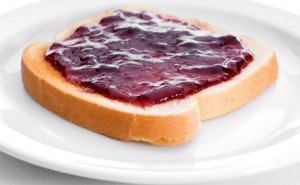 Original article by Jill Frank – published Apr. 4, 2014
Original article by Jill Frank – published Apr. 4, 2014
Updated by Gavin Van De Walle on Feb. 2, 2022
Natural gums are hydrophilic polysaccharides derived from plant or microbial source. Depending on the source from which they are derived, they can be classified as plant exudate gum, seed gum, microbial gum, or marine gums like carrageenan.
Of these types, seed gums are particularly rich in galactomannan, which binds water, prevents ice crystals in frozen products, emulsifies, moisturizes, thickens, stabilizes, and suspends many liquid-solid solutions.
While many plants contain galactomannan, guar is one of the few gums manufactured commercially.1
Guar gum hydrates rapidly in cold water. It produces a uniform, high viscosity gel that aids in thickening a wide variety of food categories.
Here are a few examples1:
- In frozen foods, it aids in crystal growth, separation and syneresis control.
- In fried products, it helps reduce oil uptake.
- In condiments like ketchup and dressings, it helps in reducing phase separation in oil-water matrixes, maintains the free flow of the product, and improves consistency.
- In beverages, it aids in improving mouthfeel and viscosity.
- In dairy foods, it maintains viscosity, improves texture and controls ice crystal formation.
- In baked goods and confectionery, it prolongs shelf life and improves freeze-thaw stability. It also controls moisture, stabilizes the crystallization of sugars. In gluten-free baked goods, guar gum mimics the structure-building visco-elastic properties of gluten.
- In pet foods, it aids in moisture retention, thickening, and stabilizing.
And although guar gum is one of the cheapest hydrocolloids with a strong safety profile when used in permitted levels by regulatory agencies, guar gum prices have taken a roller coaster ride. Over the last few years, guar gum prices have steadily decreased but have recently begun to increase to new highs, in part from a revived demand from the oil exploration sector and poultry and animal feed industry.
As such, manufacturers have sought alternatives with similar proprieties to offer cost and product stability, while prices in the entire hydrocolloid industry have the potential to fluctuate.
Alternatives should be considered for their use rate, as well as impact on taste and texture of the finished product. It is possible to blend multiple alternatives together to match or exceed individual system functionality requirements and to build a system that may help buffer any future cost issues. Suppliers may make custom blends as well.
Here are viable alternatives to guar gum:
- Xanthan gum can provide many similar properties of guar related to the ability to control moisture in finished products and remain soluble in cold water. Xanthan gum can aid in emulsion stabilization, is usually not impacted with pH or temperature changes, and offers synergistic viscosity increases when used with locust bean or guar gums.
- Locust bean gum is a good choice for systems where heat is applied and works well as a thickener where smooth, creamy textures are needed, like ice creams. When combined with other gums like xanthan gum, locust bean gum produces a synergistic effect to create firmer, stronger gels.
- Tara gum has similar properties to guar gum related to its ability to hydrate rapidly in cold water systems to provide highly viscous solutions. Tara gum also provides good air and gas entrapment and can help suspend solids in baked goods. It can also be blended with ingredients like carboxymethylcellulose (CMC) and xanthan gums to provide a smooth texture for sauces or reduce ice crystal size.
Sources
Mudgil D, Barak S, Khatkar BS. Guar gum: processing, properties and food applications — a review. J Sci Technol. March 2014;51(3): 409-218.
The views, opinions and technical analyses presented here are those of the author or advertiser, and are not necessarily those of ULProspector.com or UL Solutions. The appearance of this content in the UL Prospector Knowledge Center does not constitute an endorsement by UL Solutions or its affiliates.
All content is subject to copyright and may not be reproduced without prior authorization from UL Solutions or the content author.
The content has been made available for informational and educational purposes only. While the editors of this site may verify the accuracy of its content from time to time, we assume no responsibility for errors made by the author, editorial staff or any other contributor.
UL Solutions does not make any representations or warranties with respect to the accuracy, applicability, fitness or completeness of the content. UL Solutions does not warrant the performance, effectiveness or applicability of sites listed or linked to in any content.



Hi
what is the future roll of MCC in the industry in terms of substitution for ghar gum and its acceptability as a replacement.
Thank you